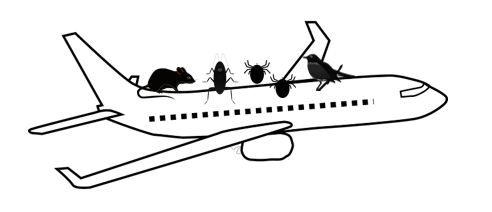While there may be no bugs and rodents in the ocean, they do love a good vessel to live in. Pest infestation in crucial sectors like the defence has proven to be extremely dangerous. The Navy in all the countries has been battling this menace for a very long time. The absence of a foolproof method has led to this becoming a recurring problem.

Many incidences of problems of bedbug and cockroach infestation in training stations, power outages in bases due to rodents, squirrels and other pests causing damage and maintenance nuisance have come to light. Apart from these, the plethora of diseases they carry by being vectors is truly horrifying.
Pests, anywhere, are extremely tiresome to deal with. However, pests in enclosed spaces like ships and submarines, especially have a record of being absolutely unmanageable. The fact that such vehicles are cut off from land for many months at a time makes it difficult to get the pests off-board.
Reports of rats and insects on ships and submarines come to light many a time over the years. Storage areas, kitchens, sleeping areas, etc. become the hot spots for such infestations. The ropes that secure these vessels to the pier, access ramps that are placed, faulty pipes and vents, rope hulls are some of the common entry points for these pests into ships and submarines. They can also be brought accidentally along with passenger/sailor luggage.
A lot of these pests can be found near the bedding racks and areas, kitchen and pantry and around waste and trash disposal. Bedbug and rodent infestations aboard ships have been reported globally and a lot of the common measures taken against the pests prove to be ineffective due to the recurring nature of the problem.
The sailors and on-board crew members experience extreme trauma because of the nature of the infestation. All the pests on-board are a constant hazard to everything else on the vessel.
“US Navy sailors have been battling a bed bug infestation aboard an attack submarine”
“Sailors aboard Seawolf-class submarine USS Connecticut, one of the US Navy’s most capable attack submarines, have been battling a bed bug infestation.
Naval Submarine Force Pacific said in a statement that the Navy launched efforts to find and eliminate the difficult-to-kill bed bugs after the problem was first reported last December, explaining that the “physical presence of bed bugs” was found in February.
Sailors told Navy Times, which first reported the infestation that the problem actually started last March while the submarine was participating in an Arctic training event. Family members of Connecticut sailors told the Kitsap Sun that the bed bug problem has been an issue for about a year.
The electric supply and therefore, everything connected to it including the communication base and the power supply, etc. in the navy is constantly at the threat of being damaged by the pests.”
“Squirrel leaves U.S. Navy base incommunicado”
“But here at home, one naval installation has discovered a new menace, capable of knocking out key communications in a matter of seconds.
Indeed, this latest threat can be found in most backyards, or any other wooded area. It typically weighs a pound—or less—and belongs to the Sciuridae family. We’re referring to the common tree squirrel, and last Saturday night, one of the furry rodents disrupted phone service at Virginia’s Yorktown Naval Weapons Station. Four days later, “land line” phones at the base still aren’t working, making communications difficult.
A senior official at the weapons station, who asked not to be identified, said the problem began when a squirrel came in contact with an electrical transformer. The rodent was electrocuted and the transformer exploded, knocking out power for a time, and seriously damaging a key component of the base phone system. Since then, callers to the installation have heard nothing but busy signals, and weapons station personnel have been unable to reach anyone, on or off the base.
Technicians were still working on the problem Wednesday morning, but there was no indication as to when phone service might be restored. Mark Piggott, a public affairs officer at the base, said software for the phone network had to be re-loaded manually, a process that could take three to six days. That means phone service might not be restored until the weekend.”
Pesticides that were commonly used to combat this menace have been deemed extremely harmful for the environment as well as the officers on board. Not only that, these pesticides do not offer a permanent solution and their application has to frequent for any results to be seen. This again raises the issue of cost-effectiveness and being a health hazard. At this point, it has become very urgent to find a solution that is long-lasting as well as safe for everyone.
We, at C Tech Corporation, have developed products that are effective, safe and budget-friendly in the long run. Our products, Rodrepel™ – the anti-rodent and anti-animal compound, Termirepel™, the anti-insect and anti-termite compound and Combirepel™, the anti-animal, anti-rodent, anti-insect and anti-bird compound, are engineered using a unique set of complex compounds. They work on the mechanism of repellence and combines the best of chemistry and green practices to give an environmentally safe product which keeps pest away effectively while at the same time guaranteeing safety to the environment. Our products repel the pest and do not kill them.
The masterbatch can be combined with any polymer during its manufacturing. These polymers can then be used to make cable sheathing for optical fibers or power cables, polymeric equipment including RADAR, communications systems, etc. It can also be used to make seat covers, utility pipes, trash cans, etc. which can be used at the base as well as aboard ships. Using these protected wires in the server and control rooms will help to make
Our liquid concentrate is compatible with all types of paints and solvents without altering the properties of paint. It can be mixed with paints in a predetermined ratio and can be applied on the interior and exterior of the vessel, on walls of the kitchen, equipment storage room, bedding area, etc.
Lacquer is a topical application that is compatible with most surfaces such as wood, ceramic, polymer, cement, etc. It gives a transparent finish to the applied product and does not wear off easily. Lacquer can be used for epoxy floorings inside the ships and in bases, already installed wires and cables, and also on the decks. Wood polish additive is specially designed to preserve wooden articles such as wooden pallets, racks, and storage boxes from all sorts of pest damage.
The bird repellent gel lacquer, when applied on window ledges, decks and other such places with the problem of bird menace, effectively keeps them away by employing the mechanism of tactile repellence.
The ready-to-use sprays can be sprayed on any type of surface and in the gaps between ceilings and headboards. The aerosol spray is also compatible with steel and metallic surfaces.
We comply with international standards of regulations. All our products are EU BPR, RoHS, RoHS2, RoHS3, NEA, APVMA and REACH compliant. We are also US FIFRA exempted.
Contact us at technical.marketing@ctechcorporation.com to keep the pests away.
Also, visit our websites:
1] http://www.ctechcorporation.com/
Follow our Facebook pages at:
1] https://www.facebook.com/Combirepel-411710912249274/
2] https://www.facebook.com/Termirepel-104225413091251/
3] https://www.facebook.com/Rodrepel-120734974768048/
Follow us on our Twitter pages at:
1] https://twitter.com/rodrepel





